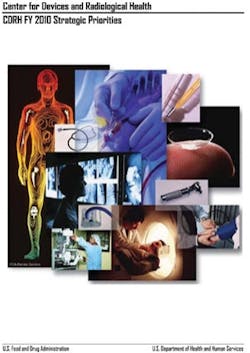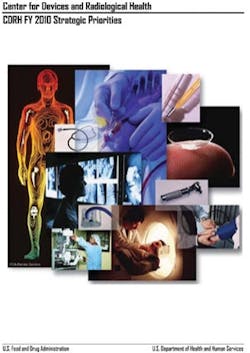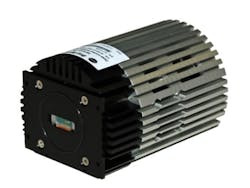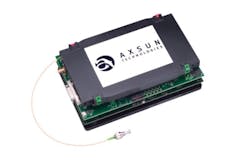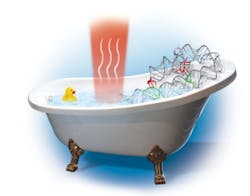Fiber laser cuts into sheet metal fabricating
David A. Belforte
It is possible that this so-called niche fiber laser cutter may have a larger market than anticipated
More Industrial Laser Solutions Articles |
Fiber laser cutting thin stainless steel Fiber lasers penetrate the precision tube cutting industry |
Three years ago I reported, along with my colleague Antonio Vendramini, on the rise of high-power fiber lasers for sheet metal cutting applications.1 We had just visited a company in Italy, Finsomac s.r.l. (www.finsomac.com), that had initial success in supplying a 1 kW fiber laser powered unit to some Italian sheet metal fabricators. With Finsomac personnel we also visited some of the company's customers in the Milan area and learned that contrary to our (somewhat prejudicial) view of CO2 as the only laser source for that application, these users convinced us that the fiber laser, because of its operating cost, might have a larger role to play in the fabricated metal products industry. At that time we asked the question "Is it possible that this so-called niche laser cutter may have a larger market than anticipated?"
Now, three short years later, the answer appears to be a decided yes. Starting from a 2006 market of less than a dozen units, the annual sales of fiber laser cutters has recently been estimated at about 3% of total 2009 sales of high-power laser sheet metal cutters. The total number of fiber laser cutters installed through 2009 is estimated at 170-175 units and is expected to double the total this year with growth next year projected at 50-60%.
It is important, at this point, to establish the market size. Laser sheet metal cutting systems, powered by high-power CO2, total more than 50,000 units installed worldwide since 1980; and annual sales are in the 3500-4000 unit range. So penetration into this market by high-power fiber lasers will produce waves in the system supplier industry. First, fiber lasers will likely take market share from the CO2 laser suppliers. Even if only 3% of last year's sales would have been for fiber–a mere pinprick in the market–it could be considered a growing competitive nuisance by high-power CO2 laser suppliers. Second, fiber lasers may expand the total cutter market by their appeal to entry level users, who would not have shown interest in the CO2 units. And third, the suppliers of flat sheet cutters, currently numbering more than 50 global companies with commercial systems may, when faced with new competition, move to add the fiber laser product to their marketing mix; an example is noted later in the review. These are three key factors that will certainly cause some market disruption in the next few years. For example, in this review we report on two new suppliers of fiber laser cutters just entering the market–one an established CO2 laser system supplier, the other a new system entrant.
Why does the fiber laser as an energy source for sheet metal cutting attract interest? The tightly focused spot size, resulting from high beam quality of the shorter wavelength fiber laser, offers faster processing speeds, with a larger working distance and higher depth of focus. The latter two advantages can ease workpiece tolerances.
The higher optical efficiency of this laser coupled with a more efficient use of wall-plug power reduces utility costs for electricity and cooling. The longer life of pumping diodes and the extended mean-time between maintenance make this laser an attractive option for small shops.
The compact cutting head facilitates simple integration into motion systems, reducing the complexity of large cutting tables; and these lighter components can be moved at higher speed with fewer components and lighter structures, reducing motion power while still maintaining accuracy. The fiber laser is the delivery device, eliminating the need for multi-mirror alignment procedures and, as the beam is contained in the fiber, the beam path is sealed to the cutting point.
What had first been suggested as a negative for fiber lasers was eye safety. All commercial lasers sold in North America and Europe must comply with safety standards, and equipment manufacturers have adapted their product designs for compliance. For sheet metal fabricating it is difficult to design to a Class I enclosure concept, as shuttle tables may need to access the cutting area for load/unload operations. So most flat sheet cutters powered by CO2 lasers operate on a Maximum Permissible Exposure basis with the operators positioned far enough away from the beam/material interaction point so that reflective energy is dissipated. With the solid-state ytterbium fiber lasers, operating at 1.06 μm, it is necessary to restrict operator access to the beam interaction point behind safety enclosures. Most fiber laser cutter suppliers comply with this one way or another. Thus the safety situation has been mitigated.
The first successful commercial fiber laser metal cutters were manufactured and sold in Italy by Finsomac and India by Sahajanand Laser Technology. Between these two companies about 100 units have now been sold. The logjam, if you will, was broken at EuroBlech in Hanover, Germany, two years ago when a half-dozen cutting system suppliers showed products. One of these, Salvagnini, sold more than 40% of the total 2009 sales. –D.B.
SUPPLIERS OF FIBER LASER POWERED SHEET METAL CUTTING SYSTEMS
AS OF THIS WRITING there are 15 known suppliers of fiber laser powered sheet metal cutting systems that responded to our requests for information. What follows is a profile of the supplying companies and their products.
After more than four decades of focusing on plasma cutting, Hypertherm Inc., West Lebanon, NH (www.hypertherm.com), plans to enter the fiber laser sheet metal cutting market later this year, with an introduction at Fabtech, showing a fully integrated and automated system that includes a fiber laser source (a company developed 1.5 kW unit), optics delivery, cutting head, all consoles, motion controls, and software in one package (FIGURE 1 and COVER PHOTO). The market strategy is to identify OEMs that can integrate this package with their motion systems and end users that currently have motion systems for plasma cutting and wish to adapt these for high-precision laser cutting of thin gauge metals.
"Our system really lowers the barrier for potential users since we've done all the work, including defining the cutting parameters, in advance," says Doug Shuda, Hypertherm's fiber laser product manager. "This means companies no longer have to choose between plasma and laser. They can do both, choosing the best process for each particular job."
An attractive benefit of fiber laser is that it requires virtually no maintenance, and is more energy efficient than CO2 lasers. And fiber lasers also have the upper hand when it comes to floor space and table size. Plus, the fiber laser power source is smaller than CO2 and works well on larger tables.
Adira SA, Porto, Portugal (www.adira.pt), has been supplying innovative products and solutions for the sheet metal working industry since 1956. The company introduced the Adira LF, a 2 kW fiber laser powered sheet metal cutting system several years ago, offering the ability to cut stainless steel up to 8 mm and mild steel up to 18 mm. The option to cut reflective metals such as aluminum, copper and brass make the LF (shown in FIGURE 2) an ideal, flexible tool for jobshops. Maximum productivity is established with linear motor cutting speeds to 40 m/min in 1 mm stainless steel, 280 m/min positioning speed, and 2.8 G acceleration. Coupled with high fiber laser beam quality, high wall plug efficiency, and reduced maintenance schedules, the LF is a cost effective cutting machine.
Air Liquide Welding France, Cergy Pontoise, France (www.airliquidewelding.com), a world leader in thermal cutting technologies, three years ago patented and launched Fibertome 3015, a 2 kW fiber laser powered cutting system capable of handling workpieces up 1500 × 3000 mm. Designed to increase productivity and to reduce cost at the same time, Fibertome 3015, as shown in FIGURE 3, uses the fiber laser to halve the cost of electrical power and to eliminate: shielding gas, optical alignment, laser service, and high pressure compressors while reducing the system's footprint and power supply costs. A Windows-based Human Machine Interface with an LCD touch-screen provides a comfortable workstation that is easy to use. An optional load/unload system makes the Fibertome 3015 a completely automatic machine for sheet metal cutting.
Cutlite Penta S.r.l., Calenzano, Firenze, Italy (www.cutlitepenta.com), part of the El.En. Group, since 1992 has sold globally more than 600 CO2 laser cutting systems (100 in the USA). Recognizing the advantages of the high-power fiber laser, the company introduced the Cutlite Penta PLUS System, shown in FIGURE 4, available with a 1- and 2 kW fiber laser mounted on linear motor cutting tables ranging in size from 61 in. × 101 in. to 81 in. × 240 in. The 1 kW fiber laser option covers the range up to 4 mm, and the 2 kW extends this to 12 mm. With the fiber laser, maximum cutting speeds with high accuracy and repeatability are delivered for cutting brass, copper, and aluminum.
Danobat Group, Elgoibar (Gipuzkoa) Spain (www.danobat.com), adapting to changing industrial circumstances and demands, continues it pioneering role by offering the Combined Fiber Laser (see FIGURE 5) that satisfies more fully the needs of customers, optimizing the manufacturing processes through an appropriate mix of punching, cold cuts, marking, threading, and laser cutting. The main advantages of fiber laser are less energy consumption, less consumables (mirrors), less maintenance (alignment of mirrors), and less time for installation and commissioning. Two models, powered by a 1.5 kW fiber laser, are available: the Silver 30 with a 1500 × 3000 mm working area and the Silver 40 with a 1500 × 4000 working area.
Finsomac s.r.l., Schio (VI) Italy (www.cy-laser.com) started developing in conjunction with other companies, a high brilliance (fiber laser) laser cutting system and introduced the Cy-Laser in 2006. By the end of 2009 Finsomac had delivered 60 systems and 2010 orders were approaching another dozen. Cy-Laser is available in four models with cutting tables from 3000 × 1500 mm to 6000 × 2500 mm, each with Z axis to 300 mm (see FIGURE 6). Standard equipment includes: double motorized pallet changer, standalone "aircraft" frame structure, fume collection systems, chiller, PC command control console, cutting software, and machine management and diagnostics. Slewing speed is up to 111 m/min. The fiber laser uses a single focus lens with time-consuming changeover for varying material thicknesses; and the laser allows cutting of reflective metals as well as steels.
Laser Photonics, Lake Mary, Flor. (www.laserphotonics.com), started selling the FLC Series fiber laser cutting systems in 2008, offering a capability to cut metal up to 25 mm thick using up to 10 kW of power. The FLC Series is available with single- or dual-pallet shuttle tables. The FLC 5X10 (shown in FIGURE 7) has a 1676 mm × 3076 mm bed, with positioning speed of 2 m/s using linear motor drives, and repeatability of 10km. It is fully software controlled, and geometry alignment eliminates the need for special installation requirements. With no mirrors and optical system alignment, laser service, or laser replacement parts, this system is virtually maintenance free. The FLC Series can cut aluminum, alloy metals, stainless steel, copper, brass, non-transparent plastics, and more.
Prima Industrie S.p.a., Collegno Turin, Italy, (www.primaindustrie.com) and Prima North America Inc., Chicopee, Mass., has introduced the Rapido Evoluzione 2, a multi-axis flying optic system where the workpiece remains fixed throughout the work process, shown in FIGURE 8, that can be powered by either CO2 lasers up to 5 kW or fiber lasers up to 3 kW. The low floor space system handles workpieces in a 1350 × 4080 × 765 mm working envelope, in an automatic protection cabin with optimal fume extraction and 3-side full accessibility. Control is by the latest generation PRIMAC-30L with touch-screen and trackball for high performance processing. Options include: CAD/CAM software for 2D and 3D off-line programming, CNC rotary axis for tube processing, and automatic load/unload.
Promotec srl, Mestrino (PD) Italy (www.promo-tec.com), has been producing cutting systems with laser, plasma, oxy-flame, and drilling technologies since 1993, with each of these used alone or combined with the others. The new flexible and economical fiber laser technology can be combined with plasma and mechanical drilling systems. The Xtreme (shown in FIGURE 9) linear motor laser cutter cuts from 1500 to 3000 mm wide and 3000 to 12,000 mm in length. The Xper rack-and-pinion movement system handles metal up to 2000 mm in width and 6000 mm long. The Xdream is a laser machine combined with plasma and a drilling unit with dimensions up to 4000 mm wide and 30,000 mm long. Each laser cutting machine has a cutting head with automatic zoom, changing focal length from 3.5 to 11 inches.
Adige, a member of the BLM Group, located in Levico, Italy (www.blmgroup.com), with a North American location in Wixom, Michigan, is a world leader in the design and manufacture of automated laser tube cutters. The company has installed a large quantity of CO2 laser powered units worldwide, and it recently introduced Lasertube LT Fiber (see FIGURE 10), a 2 kW fiber laser powered round, square, and rectangular tube cutter, capable of handling ferrous and non-ferrous metals, including brass and copper. The fiber laser produces the highest beam quality available, which leads to precise, sharp cuts in profiled shapes. Use of the fiber laser enables reduced electrical costs, faster cutting speeds, reflective metal processing, and reduced maintenance costs.
Salvagnini Italia S.p.A, Sarego (VI) Italy (www.salvagnini.it), and Salvagnini America, Hamilton, OH, adapted the L1X CO2 laser cutter design to the first fiber laser cutter, L1Xe, which reduces cost per part by 50%, while providing a 70% reduction in electrical power. Cutting speeds in thin metal are enhanced–for example speeds are 60-100% faster than CO2 for thicknesses below 3 mm. The L1Xe (see FIGURE 11) can operate as a standalone cutter or as part of an integrated cell with sheet loaders and the company's MCL Cartesian sorter. The system is ideal for shops with restricted floor space because the fiber laser technology leads to a smaller footprint thanks to a compact resonator and chiller. The L1Xe is available in two table sizes; 120 in. × 60 in. and 160 in. × 60 in.
Sahajanand Laser Technologies Ltd., Gandhinagar, Gujarat, India (www.sahajanandlaser.com), first offered a 1 kW fiber laser cutting system in 2000. Since then the company has sold a quantity of these units to companies in several countries. The Bhrahmasta is powered by fiber lasers ranging in output power up to 3 kW, can be integrated in several table and motion arrangements, either rack and pinion or linear motor driven, with capacities from 1500 × 3000 mm up to 2500 × 6500 mm, controlled by a Siemens PC with easy user interface. (Photo of product was not available as of press time.) Options offered include scrap removal conveyor, dual pallet changer, automatic load/unload, rotary axis for tube cutting, and 3D cutting head. SLT, founded in 1992, has supplied 2000 laser systems to more than 18 countries for cutting, welding, marking, and other applications.
Stiefelmayer-Lasertechnik GmbH & C0. KG, Denkendorff, Germany (www.stiefelmayer.de), has specialized in constructing customer-specific laser machines and process development in the area of laser cutting. Several years ago the company recognized that a major challenge in laser cutting was obtaining the highest levels of precision at maximum speed. And it introduced the Stiefelmayer effective, a purpose designed fiber laser powered system that has all its moving structural parts made of carbon fiber, driven by linear motors. The effective (see FIGURE 12) is designed to process thin sheet metal with production times reduced up to 30%, using less energy than an equivalent CO2 laser, with the precision of the machine transferred exactly to the component to be cut and operating on a virtually maintenance-free basis.
Amada Co. Ltd (www.amada.co.jp), recently announced that a 4 kW fiber laser, jointly developed with JDSU, when combined with the company's high-speed linear drive system, will allow the cutting of lighter gauge stainless steel and aluminum 2.5 to 3 times faster than CO2 based systems. The company cites the benefits of fiber laser cutting as flexible beam delivery, reduced electrical power consumption, compact footprint, low maintenance costs, and effective beam focus over a greater working length. Amada plans to start selling to the Japanese market in May 2011 followed by a global introduction in June 2011. In the meantime, however, the company will preview the fiber laser this October at EuroBlech in Hanover.
TRUMPF Inc. Farmington, Conn. (www.us.trumpf.com), will officially debut the TruLaser 1030, a new 2D cutting system based on the company's successful TruLaser 1030 but equipped with a fiber-guided TruDisk 2001 laser. This system is ideal for fusion cutting light gauge material up to 0.160 in., including copper and brass, at a low investment and operating cost. It will be introduced at Fabtech in Atlanta in November. New to the North American market but already introduced in Europe is the TruLaser 5030 (see FIGURE 14) also mounting a fiber guided TruDisk 3001 and the TruLaser 7000 for 3D processing with five axes of motion. This system is available with either CO2 or the TruDisc 3001 lasers. TRUMPF is considered to be the world leader in supplying laser-based sheet metal cutting systems.
Reference
1. David A. Belforte and Antonio Vedramini, "Two-dimensional fiber-laser cutting premieres," Industrial Laser Solutions for Manufacturing, Sept. 1, 2007 (http://www.optoiq.com/index/lasers-for-manufacturing/display/ils-article-display/305169/articles/industrial-laser-solutions/volume-22/issue-9/features/application-report/two-dimensional-fiber-laser-cutting-premieres.html).
ILS made an extra effort to identify and contact all known manufacturers of fiber laser flat sheet metal cutters. The criterion for inclusion in this feature is that the product is currently available in the marketplace. Companies with such a product that chose not to respond to numerous attempts to obtain information were, therefore, not mentioned.
More ILS Current Issue Articles
More ILS Archives Issue Articles
